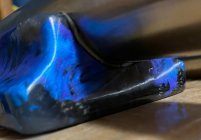I was born into the wrong generation but I believe it is entirely reasonable to use pressure between the stock and forearm to dampen vibrations.
This picture shows the relative size, weight and length of two Remington 700 barrels, and two F-Class barrels. The weights are written beside the tenons.
The 1.25” F-Class barrel has a Panda tenon and the 1.45” tapered to 1.0” barrel has a Surgeon XL tenon. While the Surgeon tenon is largest in length and diameter, the
barrel is over 12 pounds. Yes, the action is 4.5 pounds, but the stock dimensions in the stressed area are not particularly different from what would be sent for a 700, in fact the contacted supportive area is likely thinner because the action is thicker, the mold isn’t changing, and the trigger must correctly protrude. The action screws have a few more threads but are the same size.
View attachment 1318932
To my thinking, my composite stocks benefit from supporting the barrel. I use something semi-compressible which I calculate by feel and appearance to begin compression as the screws are torqued. I seek to have
some upward pressure on the barrel, but I do not try to turn the stock into an archer’s bow. I make absolutely certain the amount of material does not prevent the action from making full, flat contact with the stock. This is verifiable both by feel when tightening, and visually if one can discern very small angles, or if not, by witness marks on tape that would need to be equal front to rear.
View attachment 1318933
I also do feel that my barrel’s propensity for harmonic resonance is diminished, though I don’t know how much these very heavy profile barrels want to resonate. I do this primarily because I feel that a 12 pound barrel exacerbated by 35 inches of length on those screws, the stock and action is a bit like picking up a toddler by the wrist.
I have shot and purchased completed F-Class guns that are free floated and shoot very well, but I can feel the post-shot vibrations that I believe are caused by whip and It’s distracting to me. I would agree that this type of rebounding could either be post exit, not material to accuracy, or in any event, tunable by load or by tuner, but to me, I’m inclined to minimize it if possible, meaning without sacrificing accuracy. To me, those vibrations would seem to be working against the action screws to loosen things up.












